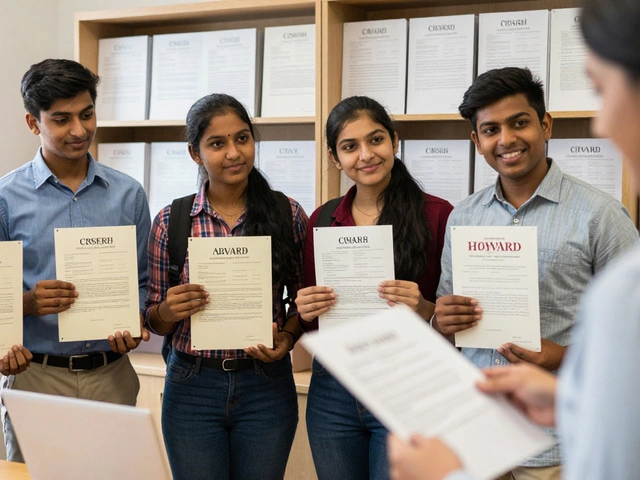If you're into math, there’s a strange kind of glamour in chasing the world’s most infamous problems. Some kids sweat over essays; others cram vocab. But the select few with a taste for numbers? They chase questions that can fry your brain before your breakfast is cold. So, what sits at the top of the math exam mountain? Is it all about brilliant teenagers at the International Mathematical Olympiad? Do the universities have their own ‘boss level’ challenge in the Putnam? Let’s peel back the layers and see what tests truly sit on the math throne—and why winning them can change your life.
Defining Prestige in Mathematics: More Than Bragging Rights
Not all math exams are born equal. Some have legend—stories of high schoolers solving questions professors puzzle over, or undergrads going viral for perfect scores. Prestige in a math exam is a cocktail of tradition, international reach, jaw-dropping difficulty, and the doors it opens. To be blunt—some tests aren’t just tough; they’re a ticket to Ivy Leagues, Google, and the kind of circles where a Nobel laureate might buy you lunch. Want to see your name in academic folklore? The right math exam can make you part of a club so exclusive your own classmates might not believe it exists.
It isn’t only about being hard. Plenty of exams are difficult. Prestige comes from history—like the stories of Russian students braving snowdrifts to reach the All-Russian Olympiad, or Americans whispering tales of the elusive Putnam Fellowship. An exam’s reach matters, too. The International Mathematical Olympiad (IMO), for example, brings together teens from over a hundred countries. If you win there, you’re basically math royalty. Universities and Big Tech alike often hunt for Olympiad medalists, eager to snap up proven problem-solvers.
Network effects matter. If winners go on to shape the world, teach at MIT, or win Fields Medals, the prestige of that exam grows. Look at Terence Tao, who bagged a gold at the IMO at just 13. Or Richard Feynman, who crushed the Putnam before dazzling the world of physics. So, prestige is infectious: it’s as much about who’s walked the road before you as the way ahead.
But the world isn’t flat. What counts as “the” test depends where you live. In the U.S. and Canada, the Putnam reigns. In much of Europe, national Olympiads are legendary. In Australia or China, the pressure and training for the IMO can start before your voice breaks. The shared feature? A hard-earned, widely-recognized badge that proves your brain can tangle with the best. That mix—history, winners, impact—is what makes one math contest more than just a piece of paper.
Ok, so how do these legendary exams actually work? And which ones are the real dragons?
The International Mathematical Olympiad: Math’s Biggest Global Arena
The IMO is the World Cup of math. Since 1959, when it began in Romania with just seven countries, it’s ballooned into a huge annual showdown. Now, more than 100 nations battle it out, each sending up to six students. It’s almost gladiatorial—except the weapons are proofs, not swords. The questions? They’re pure, tricky as a Rubik’s Cube dipped in oil, and designed so that even math prodigies might finish with a blank page.
Here’s the format: over two days, kids have 4.5 hours each day to grapple with three questions—just six in total. Most people might see that and think, “Six questions in nine hours? Easy.” But here’s the trick: even scoring a single point is seen as an accomplishment. Full marks? That’s movie material. At the IMO, tasks mostly cover geometry, combinatorics, number theory, and algebra—never calculus or university-level material. The idea is to test creative insight, not raw memory. You can’t “study up” the night before and expect to ace it.
Many former IMO medalists go on to game-changing careers in academia, cryptography, and Silicon Valley. Some, like Maryam Mirzakhani (a 1994 gold medalist), become renowned mathematicians winning the Fields Medal—the closest thing math has to a Nobel Prize. The contest itself is fiercely protected against cheating: exam problems are shrouded in secrecy, and organizers take pride in producing questions nobody’s seen or solved before.
Let’s stack up some numbers for perspective:
| Year | Countries Participating | Top Score (out of 42) | Zero Scores |
|---|---|---|---|
| 2010 | 97 | 41 | 159 |
| 2015 | 104 | 42 | 118 |
| 2022 | 104 | 42 | 94 |
| 2023 | 112 | 41 | 86 |
Nearly 10-20% of participants struggle to score even a single point—these are students who’ve already won at national level. That’s how tough the IMO is. Just finishing on the scoreboard shows serious skill.
Some South African students have punched above their weight too: in 2023, Cape Town’s own Siyabonga Mkhize scored silver—the country’s best result in a decade—sparking a fresh wave of Olympiad interest in high schools countrywide. It’s proof that the IMO’s influence is growing everywhere, not just in math “powerhouses” like China and the US.
Want to train for the IMO? It’s not for the faint-hearted. Olympiad clubs meet weekly, hunched over old problems dating back to the 1960s, swapping hints and taking pride in thinking “outside the textbook.” Platforms like Art of Problem Solving now have global users, and even kids in remote areas can get in on the action. The key is persistence—some who bomb their first regional Olympiad return, year after year, to finally bust through the qualifying wall and make that flight to the IMO stage.

The William Lowell Putnam Mathematical Competition: The Undergrad Gauntlet
If the IMO is for school whizzes, the Putnam is the proving ground for American and Canadian university students. Founded in 1938, the Putnam Competition is less global than the IMO, but its prestige in North America is legendary. Across the U.S. and Canada, stories abound of math departments that worship the test. Just placing in the top 500 is seen as badge-worthy. The Putnam isn’t about speed or obscure topics—every year, it throws twelve problems at students, all meant to crush your regular “good at math” self-esteem.
Held on a Saturday in early December, the test runs for six hours—three hours in the morning, three after lunch. The questions can be jaw-dropping. Some are deeply tricky; others require proof or creative logic that push you straight to the edge. The median score isn’t half marks—it’s shockingly low, usually between 0 and 2 out of a possible 120 points. A perfect 120? No one’s ever done it. In fact, some years, the top score is just in the 90s. A prestigious math exam doesn’t mess around.
Check these stats (for recent years):
| Year | Participants | Median Score | Top Score |
|---|---|---|---|
| 2018 | 4275 | 2 | 93 |
| 2020 | 2171 | 1 | 96 |
| 2022 | 2560 | 2 | 93 |
Getting a 'Putnam Fellowship'—a top 5 spot—opens doors to elite PhD programs, research opportunities, and the kind of bragging rights that make you campus-famous. Prizes come with money, sure, but also lifelong reputation. Famous former winners include John Nash, noted in “A Beautiful Mind,” and future Fields Medalists like Daniel Spielman. Recruiters at places like Google and Jane Street know a Putnam name means “this person can wrangle problems no textbook teaches.”
Universities compete ferociously too. Winning schools get credit for the brainpower assembled. Some campuses make a tradition out of prepping—think late-night math circles and secret blackboards. Students who didn’t study as kids can build Olympiad skills in college by training with Putnam veterans and professors. The best advice? Don’t assume last year’s tricks will work. Questions are fresh every year, and the test rewards those with the guts to gamble on wild, creative solutions.
Unlike the IMO, which tests high school ingenuity, the Putnam is the intellectual Everest for undergrads. Its long-standing history means winning grants instant credibility in mathematical and professional communities worldwide, even though it’s mainly a North American affair. Walk into a faculty meeting at MIT or Caltech and mention you ranked high—watch the heads turn.
The Challenger Exams: Asian, European, and National Legends
Hang on—there’s more to the story than just the IMO and Putnam. Asia, for instance, produces some of the world’s fiercest math talent, thanks to legendary contests like China’s National High School Math League and the Asian Pacific Mathematics Olympiad (APMO). These don’t just train top scorers—they select and prepare teams that routinely dominate the IMO leaderboard.
In Europe, Olympiads are a badge of honor. Russia’s storied All-Russian Mathematical Olympiad is older than the IMO itself and has fed talent into Soviet and Russian scientific establishments for generations. The UK’s “British Mathematical Olympiad” is a bloodbath for top sixth-form students, with winners guaranteed a place at Cambridge or Oxford if they want it. Germany, Hungary, and France each run multi-round contests to spot the most creative young minds, with successful competitors often becoming future professors or inventors.
India has its mind-boggling Indian National Mathematical Olympiad (INMO), which leads to the intense Mathematical Olympiad Program for IMO hopefuls. In the last decade, Indian schools have stepped up, with training camps resembling bootcamps in rigor—intense coaching, mock exams, and mentorship from ex-medalists. Some of South Africa’s own top math students head overseas for these camps, blending global flavors with local flair.
Let’s not forget the impact of collegiate competitions outside the Putnam. Europe’s International Mathematics Competition for University Students (IMC) draws sharp minds from across the continent. Eastern European universities see it as a pipeline to prestigious grad schools and tech jobs.
The common thread? Every region builds its own “bench” of math superheroes, and prestige is always a blend of historic results and future promise. Yes, the IMO and Putnam hog the limelight, but these regional giants create their own legends. And for those who make the cut, the rewards—whether scholarships, job offers, or a permanent place in school lore—are all very real.
Quick tip: If you’re gunning for these exams, network. Find a mentor who’s been there. Scan through years of past problems. There’s a whole subreddit for math contests, with memes, advice, and last-minute tips to keep you company the night before game day. Online study groups spring up ahead of key dates, often crossing international time zones. You’re not alone, not by a long shot.

How To Prepare: Tips, Myths, and the Real Test Beyond Numbers
Ready to brave the heights? Getting into the world’s toughest math exams isn’t about rote learning giant textbooks or memorizing theorems by heart. The prep game leans heavy on problem-solving, not just drilling exercises. In fact, top tutors say the biggest myth is that natural talent trumps hard practice. The real winners treat every contest as a puzzle, not a checklist.
Start with old problems—seriously, it’s like a secret code. The more you see, the more tricks you spot. Next, find a study buddy or competition group; bouncing ideas off others is half the fun (and pain). Don’t fear a blank page—every math legend has stories of “solutions found in the shower” or breaks that sparked insights late at night.
Feel stuck? Even international stars bombed early rounds. It’s the comebacks that matter. Don’t be afraid to read solution guides (after you’ve truly tried). Some even recommend “teaching” a tough question to someone else; that’s when you realize what you know, and what holes need patching.
On test day, nerves hit everyone. What helps? Breathe, block the noise, pretend it’s just you and one beautiful, stubborn math puzzle. Pace yourself. A few minutes sketching ideas can save an hour’s panic later. Remember: you’re not alone feeling stuck. The very essence of these contests is that almost nobody finishes, and nobody finds every answer right away.
And hey, if you win, that glory sticks. Suddenly, your achievements are recognized not just in your school but across borders. Doors swing open—from special university invites to real-world jobs where out-smarting problems is the day job. Prestige in math isn’t just about marks—it’s the proof you belong in one of the world’s smallest, coolest clubs.




